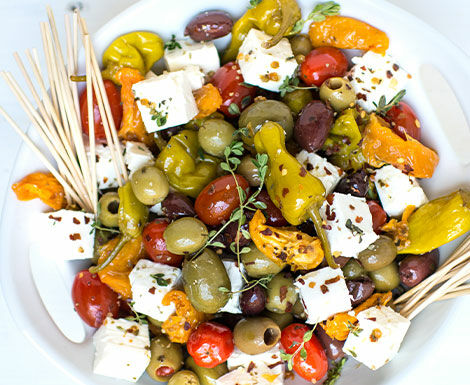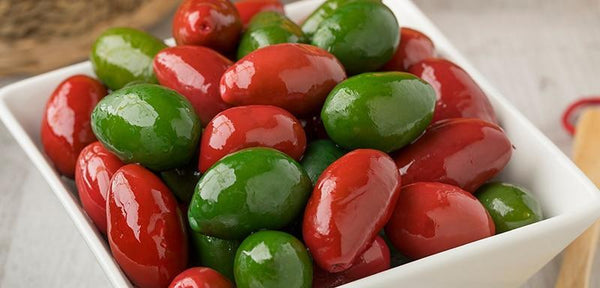If you’re assembling a charcuterie board and want it to shine, don’t underestimate the power of olives. They bring a wonderful briny counter-point to rich cheeses, cured meats and sweet fruit. According to experts, picking a few contrasting olive varieties is smart: “lean into the many varieties of olives… they provide a briny contrast to creamy cheeses and sweet jams.
Here are five top picks that are crowd-pleasers and board-worthy.
1. Castelvetrano olives (Italy / Sicily)
Why they stand out:
-
These are large green olives from Sicily (cultivar “Nocellara del Belice”) noted for their mild, buttery, almost fruity flavour rather than the sharply briny bite of many olives.
-
Because of that mild-buttery profile they pair beautifully with creamy cheeses (Brie, triple cream) without being overpowered.
-
For a charcuterie board they provide a bright visual (pale green) and a textural contrast—meaty but approachable.
Tips:
-
Serve them with pits (if they are whole) for best flavor and texture. Some reviews say pitted versions lose a bit of texture.
-
If you can find the fresh Sicilian-season ones (Sept/Oct harvest) all the better.
-
Offset their mildness with something sharper nearby (e.g., a vinegary olive) so the board has tension.
2. Kalamata olives (Greece)
Why they shine:
-
These are dark‐purple to black olives, often preserved in wine vinegar, with a more intense, tangy, savory flavor.
-
Their stronger taste makes them a good counter-point on a board with fatty meats or milder cheeses—the bold olive flavor cuts through richness.
-
They visually provide contrast (darker color) which helps the board pop.
Tips:
-
Drain off excess brine so the board doesn’t get soggy.
-
Pair them with Mediterranean cheeses (sheep’s-milk feta, halloumi) or smoky salamis for synergy.
-
If you want to go even more premium, look for Greek PDO Kalamata olives (which link to region).
3. Cerignola olives (Italy)
Why they’re a standout:
-
These Italian olives are among the largest table-olives you’ll find — bold visual size, which adds drama to your board.
-
Their flesh is rich but still mild enough to not overwhelm. According to olive rankings, they offer that “meaty flesh” texture that’s pleasing for snacking.
-
Good for stuffing (blue cheese, garlic, etc) or simply serving whole.
Tips:
-
Use as a visual anchor: place a bowl or pile of Cerignolas in one section to draw the eye.
-
To elevate, stuff a few with garlic cloves or feta for extra flavor.
-
Because they’re larger, ensure they’re pitted (or provide a small bowl for pits) if serving whole.
4. Manzanilla olives (Spain / California)
Why they’re a smart choice:
-
A classic Spanish table olive: often green, sometimes stuffed with pimiento or garlic, with a balanced, slightly nutty, briny flavor.
-
Because they’re familiar and well-liked, they act as a “safe bet” for guests who might not love ultra-bold olive flavors.
Tips:
-
Choose a stuffed version if you want extra flavor (e.g., garlic-stuffed Manzanillas).
-
Place them near cheeses and meats that lean sweeter (e.g., apple-slices or honeyed nuts) — the olive provides the salty contrast.
-
For variety on the board, combine with one mild olive (e.g., Castelvetrano) and one bold (e.g., Kalamata) so you get a spectrum.
5. Picholine olives (France / Provence)
Why they’re worth including:
-
This lesser-used varietal (French origin) is known for its firm texture, slightly pointed shape, and slightly grassy-nutty "Flavor".
-
Because it’s more “boutique,” adding Picholine gives your board a gourmet flair, signalling you’ve thought about the olive selection.
-
Great for guests who appreciate something a little different.
Tips:
-
If you can find the “cocktail” style Picholine (small size, firm texture) it works especially well as a quick grab-snack on the board.
-
Provide a little bowl of toothpicks near them — their shape often invites pick-up.
-
Offset their slightly grassy note with a sweet accent (figs, dried apricots) to round the flavor.
Putting It Together: Olive Strategy for Your Board
Here are some quick strategies to ensure your olive selection enhances your charcuterie board rather than gets lost:
-
Aim for variety: Mix one mild (e.g., Castelvetrano), one medium (e.g., Manzanilla), and one bold (e.g., Kalamata). This gives flavor contrast.
-
Use small bowls or rails: Olives tend to roll and brine can leak; place them in contained dishes so the board stays neat.
-
Visual balance: Select olives of different colors (bright green, dark purple) and sizes (large Cerignola vs small Picholine) so the board isn’t monochrome.
-
Pair thoughtfully:
-
With cheeses: creamy cheeses like Brie & triple cream → Castelvetrano; sharper cheeses like aged cheddar → Kalamata.
-
With meats: fatty prosciutto or salami → something tangy like Kalamata; milder charcuterie → something mild like Manzanilla.
-
With extras: sweet fruits (figs, grapes), nuts (almonds, pistachios), honey or jams. The brine of the olives balances sweet.
-
-
Pre-serve smart: Drain olives appropriately, remove or provide a dish for pits if present, and group them in logical “stations” on the board so guests can sample easily.
-
Label if you like: If you want to impress, small labels like “Castelvetrano (Sicily) — buttery green” add sophistication and invite guests to explore.
Why Olives Matter on a Board
-
Texture & flavour contrast: While meats and cheeses often sit in rich or creamy territory, olives add acidity, salt, and a chewy bite.
-
Crowd-pleaser & versatile: Even guests who proclaim “I don’t like olives” may change their mind when presented with a delicious variety (like Castelvetrano).
-
Visually striking: Large, glossy olives (such as Cerignola) and dark varieties (like Kalamata) provide color contrast and look elegant.
-
Pairing enhancer: Olives pair with everything from meats to cheeses to nuts to fruit; they help tie the board together into a cohesive eating experience.
Final Thoughts
When crafting your next charcuterie board, don’t relegate olives to an afterthought corner. Choose five strong, diverse olives (or at least three if limited) and place them strategically. The five above — Castelvetrano, Kalamata, Cerignola, Manzanilla, Picholine — give you flavor range, visual flair, and guest appeal.
Serve with confidence. Provide bowls for pits, maybe a small spoon for brine if needed, and let the olives shine between cheeses, meats and sweet accoutrements. Your board will feel elevated, thoughtful and – best of all – delicious.
FAQs
1. What are the best olives for a charcuterie board?
Castelvetrano, Kalamata, Cerignola, Manzanilla, and Picholine olives offer the best mix of flavor, texture, and color for a balanced charcuterie board.
2. Are green or black olives better for charcuterie?
Use both. Green olives like Castelvetrano bring a buttery freshness, while black or purple olives like Kalamata add rich, tangy contrast.
3. Should olives be pitted for a charcuterie board?
Pitted olives are easier for guests to enjoy, but whole olives retain more flavor and texture. Provide a small bowl for pits if using whole ones.
4. How do you serve olives on a charcuterie board?
Drain excess brine and serve olives in small bowls or ramekins to keep the board tidy and prevent juices from spreading.
5. What cheese pairs best with olives?
Soft cheeses like Brie pair well with mild olives, while sharper cheeses like aged cheddar or feta complement briny, tangy varieties.










